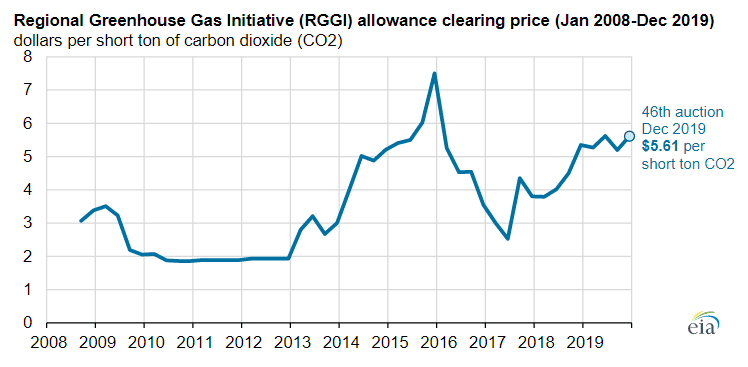Regional Carbon Auction Prices Have Improved Since 2017 Low: EIA

The 46th quarterly carbon auction of the Regional Greenhouse Gas Initiative, the nation’s first mandatory cap-and-trade program to cut power sector emissions, resulted in a price of $5.61 per short ton for the 13.1 million tons of carbon allowances sold. The clearing price was almost the same as the June 2019 price, which was the highest since December 2015, and 5 percent higher than the December 2018 auction price, according to a Dec. 10 report from the U.S. Energy Information Administration.
Clearing prices in the June 2017 RGGI auction dropped to their lowest level, marking a sharp turn from the December 2015 auction which had reached a record high. The decline in prices were due to uncertainty about the RGGI program after 2020 with regard to the future value of emissions allowances. Prices rebounded in the September 2017 auction after participating states proposed a set of changes to the program, including reducing the emissions cap by 30 percent from 2020 to 2030.
The latest auction generated $73.6 million for member states to reinvest in strategic programs, including energy efficiency, renewable energy, direct bill assistance, and greenhouse gas abatement programs. To date, RGGI states have generated above $3.36 billion in revenue from the carbon permit auction system.
RGGI is poised to expand as more states seek to join the nine-state compact. The New Jersey Department of Environmental Protection finalized regulations in June that re-establish a market-based emissions reduction program designed to enable the state to rejoin RGGI, which it left in 2012 under then-Republican Governor Christie. The RGGI states welcomed New Jersey as a participant in the regional program effective Jan. 1, 2020, finding that the rules are consistent with their Model Rule and existing state regulations.
In what would be the largest expansion of the multistate initiative since its inception in 2009, Pennsylvania’s Democratic Governor Tom Wolf issued an executive order in October directing the state’s Department of Environmental Protection to develop rules to join RGGI. The move is significant in that it would bring a major fossil fuel producing-state into the initiative, which puts a limit on carbon emissions from the power sector. Pennsylvania is the nation’s second-largest natural gas producer after Texas, and ranks third in coal production behind Wyoming and West Virginia.
EnerKnol Pulses like this one are powered by the EnerKnol Platform—the first comprehensive database for real-time energy policy tracking. Sign up for a free trial below for access to key regulatory data and deep industry insights across the energy spectrum.
ACCESS FREE TRIAL